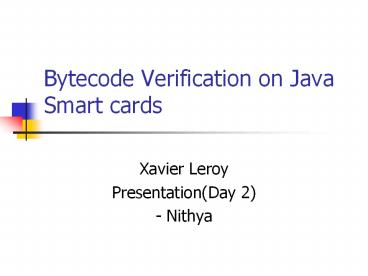Bytecode Verification on Java Smart cards PowerPoint PPT Presentation
Title: Bytecode Verification on Java Smart cards
1
Bytecode Verification on Java Smart cards
- Xavier Leroy
- Presentation(Day 2)
- - Nithya
2
JSR
- Subroutines -gt mostly used for compiling the
try-finally construct - Subroutines and Suns Verfn algorithm
- Subroutines and our Verfn Algorithm
- JSR instruction
- Ret instruction
- Role of local variable
3
Algorithm
4
JSR vs invoke
- Methods invokevirtual, invokenonvirtual,
return, areturn, Ireturn - JSR instruction and ret instruction
5
OffCard code Transformations
- Two methods to ensure that all correct applets
pass verification - Using special Java compiler
- Using a std Java Compiler and Java Card Converter
(for Off-card code Transformation) and pass it to
on card verifier
6
Applet Conversion
7
Applet Installation
8
Architecture of the System
9
Transformations
- Stack Normalisation
- Register Reallocation
10
Stack Normalisation
- For a branch with non-empty stack
- Insert stores to fresh registers before the
branch - Loads from the same registers at the branch target
11
Example C.m(b ? x y)
12
Second pass of SN
- Case 1 if i is a branch target with non-empty
stack - Case 2 if i is a branch to instruction j and
the operand stack is not empty at j.
13
1) i -gtBranch Target
- Case a
- If instruction before i doesnt fall thru (uncndl
branch/return/throw), - Insert loads from l1ln before i
- Redirect the branches to the first load thus
inserted
14
Case a
15
1)i -gtBranch Target
- Case b
- If the instruction before i falls thru
- Insert stores to ln..l1
- Load from l1..ln, before i
16
Case b
17
2) i -gtBranch to instruction j
- Case a
- If instruction i does not fall through
(unconditional branch) - Insert before i code to swap the top k words of
the stack with the n words - Insert stores lnl1
18
Case a
19
2)I -gtBranch to instruction j
- Case b
- If instruction I can fall thru (conditional
branch) - Insert after I, loads from l1ln
20
Case b
21
Worst case
- Example of combination of two transformations
- The instruction before i falls through
- i itself falls through
22
Worst case
23
Tunneling optimizations
- Idea reduce the number of branches
- Replace branches goto lbl by a direct branch to
lbl - Replace unconditional branches return or
throw by a copy of the return or a throw
instruction itself
24
Example
25
Tunneling optimization
- Conforms to Requirement R1
- No stack Normalisation needed for this code
26
Before Register reallocation
27
After Register reallocation
Number of registers stays constant
28
Chaitins graph coloring allocator
- Compute live ranges for every register
- Compute principal type for every live range
- Build the interference graph between live ranges
- Nodes -gt live ranges
- Add interference edges between live ranges that
dont have same principal type - Coalescing Detect reg-to-reg copies
- Color the interference graph
- Assign a new reg number to every live range that
2 interfering live edges have distinct reg numbers
29
After compilation and stack normalisation -gtJCVM
code
30
After coalescing sload Rtmp, sstore Rs
Short s if (b) sx elsesy
31
Effect of offcard code transformation on code
size and register
32
Comments?

